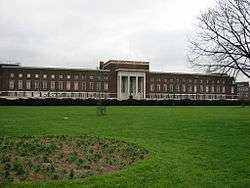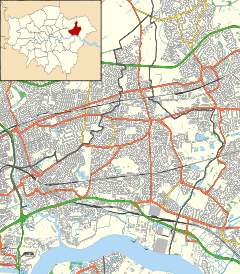Civic Centre, Dagenham
| Civic Centre, Dagenham | |
|---|---|
 | |
 Location of Dagenham Civic Centre in the London Borough of Barking and Dagenham | |
| General information | |
| Architectural style | Modern architecture |
| Coordinates | 51°33′37″N 0°09′22″E / 51.5603°N 0.15615°ECoordinates: 51°33′37″N 0°09′22″E / 51.5603°N 0.15615°E |
| Construction started | 1936 |
| Completed | 1937 |
| Opened | October 1937 |
| Renovated | 2003 |
| Design and construction | |
| Architect | E. Berry Webber |
| Renovating team | |
| Renovating firm | Richard Griffiths & Hawkins Brown |
The Civic Centre in Dagenham is a large, Grade II listed,[1] former municipal building in Becontree Heath, an area within the London Borough of Barking and Dagenham. The building was designed in the modern style by the British architect E. Berry Webber in 1936 and was opened the following year. The local authority, Barking and Dagenham London Borough Council, occupied the building until 2016 when it was vacated and leased to CU London, a new university, the following year.
History
Because of the lack of available land in London, the Housing Act 1919 permitted the London County Council (LCC) to build housing and act as landlord outside of its territory. G. Topham Forrest was appointed as the chief architect on behalf of the LCC and between 1921 and 1935 the cottage estate, comprising around 26,000 homes, was developed. The area was to be called Becontree.[2]
In August 1928, using a private Act of Parliament, the National Government of the United Kingdom purchased 135 acres, with the intention of using the area as public space. Planners decided to designate the entrance to the area, since named Central Park, as the site of a new municipal building which was intended to be the work premises for members of the local authority.[3]
Construction of the Civic Centre began in 1936 and was completed in October the following year. It was designed by E. Berry Webber who was a prolific designer of English municipal buildings. He originally intended the building to be part of a complex which was to also include a fire station, library, shops, assembly hall and theatre, but the plan never came to fruition. The land on which the building was constructed featured lily ponds which became known as "blue lagoons" by the locals. The ponds were illuminated and filled with goldfish. The fish gradually died out, and in 1953 the ponds were filled in.[4]
The Civic Centre's foundation stone was laid by Harry Snell, 1st Baron Snell on 11 July 1936.[5] The building was officially opened on 16 October the following year by Sir Kingsley Wood who was at that time the Secretary of State for Health.[4]
Design
The Civic Centre is designed in the modern style.[1] The interior features a stair hall which is made using champagne-coloured Botticino marble and the ceilings are decorated with art deco paintings. The internal doors are mostly mahogany with bronze fixtures. The Council Chamber is semi-circular in layout and is flanked by walnut-panels. The Mayor’s Parlour is panelled in Canadian betula veneer and sycamore. The building has a number of pieces of specially designed walnut furniture.[4]
Later history
In 1964 the local authority deemed the Civic Centre too small to house the 500 staff that they employed so built extensions to the south.[4] The Civic Centre, a part of the 1960s extensions, was designated as a Grade II listed building on 24 August 1981.[1]
In 2003, the building underwent a major refurbishment. The work was carried out by the architectural practice Richard Griffiths & Hawkins Brown who removed all non-original fittings and restored the original stonework. The ceiling was stripped to reveal the original paint colours. The main Council Chamber was fitted with audio-visual equipment, air conditioning, a scene-setting lighting scheme, induction loops and more flexible furniture to allow different seating plans. Also upgraded and remodelled were the meeting rooms, members lounge, washrooms, kitchen and offices. Lifts were installed in the main foyer.[4]
In March 2014, the building was threatened with closure because of the austerity measures imposed by the national coalition government.[6] Its sale had been suggested as a means to find savings of £53.5million.[7] A plan was proposed to turn the Civic Centre into a school; however, a petition, which was signed by 3,700 local residents and supporters, forced the council to defer their decision pending further information.[6] The Labour politician for Dagenham and Rainham, Jon Cruddas, led calls to retain the building as a result of overwhelming public support. Local residents called the building the "heart of Dagenham"[7] and thought that it served a purpose that "cannot be quantified".[7] In December 2015, the council disclosed their plans to scrap the sale and to allow the building to remain as the Civic Centre.[7]
CU London
In September 2017, CU London, part of the Coventry University Group, launched a new university in the Civic Centre, with permission from the council.[8] The construction company Wilmott Dixon was awarded the £4.5 million contract[9] to modernise the building for higher educational purposes.[10]
Television and film
In 2015, the building was used in the film London Road starring Tom Hardy.[11]
References
- 1 2 3 "Main Building and Council Chamber of Dagenham Civic Centre, Barking and Dagenham", British Listed Buildings, accessed 27 February 2016.
- ↑ "Homes For Heros". Locallocalhistory.co.uk. 2008-01-13. Retrieved 2016-11-24.
- ↑ "Dagenham's Civic Centre", The Essex Chronicle, 22 October 1937, p. 4.
- 1 2 3 4 5 "Dagenham Civic Centre", London Borough of Barking and Dagenham Local Studies Information Sheet No.48, London Borough of Barking and Dagenham Council, accessed 27 February 2016.
- ↑ "Dagenham Civic Centre 1935", Pathé News, accessed 27 February 2016.
- 1 2 "Campaigners against Dagenham Civic Centre herald small victory", Barking and Dagenham Post, 26 March 2014, accessed 27 February 2016.
- 1 2 3 4 "Dagenham Civic Centre saved from conversion into school", Barking and Dagenham Post, 9 December 2014, accessed 27 February 2016.
- ↑ Rasiah, Janine. "Coventry University holds open day at Dagenham Civic Centre campus". Barking and Dagenham Post. Retrieved 2017-02-10.
- ↑ Ltd, Insider Media. "Willmott Dixon wins £4.5m Coventry University contract". Insider Media Ltd. Retrieved 2017-02-10.
- ↑ "Willmott Dixon wins Coventry Uni's London campus fit-out". www.theconstructionindex.co.uk. Retrieved 2017-02-10.
- ↑ "Cheryl poses in Dagenham Civic Centre for photoshoot", Barking and Dagenham Post, 1 October 2015, accessed 27 February 2016.
External links
- Dagenham Civic Centre on British Pathé News